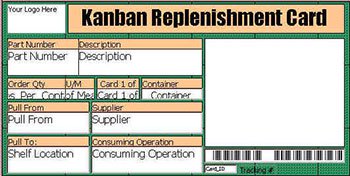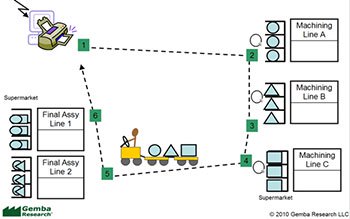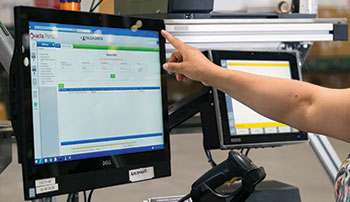
The Benefits of Automating Line Replenishment with Electronic KANBAN
Blake Bearden | 01 June 2018
Electronic Kanban paired with a warehouse management system and material handling automation offers full inventory visibility and superior efficiency.
Consider a typical manufacturing process with an assembly line and numerous workstations. At each station, individual parts are taken from stock to build on to the final product. However, as these individual parts are consumed, how do we keep track of inventory levels and make sure they are replenished in time to keep the process flowing?
The answer is using KANBAN.
The concept of Kanban originated with Toyota back in the 1940s. In a manufacturing environment, it is an inventory-control system that regulates the amount of parts in queue for individual processes. A very simplified version would be that each time a part is consumed, a replacement part is requested and delivered. However, due to the speed of consumption and the delay of replenishment, a certain number of stock must be kept in queue and a certain number must be replenished to keep the manufacturing process continuous. With the improvements and new technology in material handling, we can take the idea of Kanban to whole new levels. The question is, what level of Kanban implementation, if any, is right for you and your facility?
Level 1: Paper Kanban Cards with Manual Delivery
 Originally, the practice of Kanban in manufacturing used paper Kanban cards that workstation operators would use to signal a request for replenishment. Each individual consumable at each individual location would have an associated Kanban card and, after a predetermined inventory quantity was spent, the operator would send the card to the upstream replenishment area. Once received, the replenishment area would pull the replacement parts and send them, with the same Kanban card, downstream to the requesting workstation.
Originally, the practice of Kanban in manufacturing used paper Kanban cards that workstation operators would use to signal a request for replenishment. Each individual consumable at each individual location would have an associated Kanban card and, after a predetermined inventory quantity was spent, the operator would send the card to the upstream replenishment area. Once received, the replenishment area would pull the replacement parts and send them, with the same Kanban card, downstream to the requesting workstation.  At this level, the system is very manual. The cards and replenishment are delivered via a milk run, which can be as simple as an operator pushing a cart. On the milk run, an operator would simultaneously deliver replenishment and pick up new Kanban cards for a subsequent milk run. This process works great, but has several limitations, especially in fast-paced manufacturing environments or if there are several steps and storage locations between bulk storage and the workstations.
At this level, the system is very manual. The cards and replenishment are delivered via a milk run, which can be as simple as an operator pushing a cart. On the milk run, an operator would simultaneously deliver replenishment and pick up new Kanban cards for a subsequent milk run. This process works great, but has several limitations, especially in fast-paced manufacturing environments or if there are several steps and storage locations between bulk storage and the workstations.
Level 2: Electronic Kanban with Manual Delivery
 The evolution of Kanban and warehouse management systems has opened the door for Electronic Kanban to replace the original paper cards. Now, instead of using Kanban cards and passing them upstream for replenishment, we let computers and software track inventory levels for every physical storage location. For example, every time a workstation operator pulls a component from his or her inventory, that operator presses an associated button at that location. With each press, the software reduces the inventory-on-hand count at that location. Limits can be set so that once an inventory threshold is reached, it requests replenishment from upstream. This concept can repeat at each upstream area. This boasts several major advantages over the original Kanban card method.
The evolution of Kanban and warehouse management systems has opened the door for Electronic Kanban to replace the original paper cards. Now, instead of using Kanban cards and passing them upstream for replenishment, we let computers and software track inventory levels for every physical storage location. For example, every time a workstation operator pulls a component from his or her inventory, that operator presses an associated button at that location. With each press, the software reduces the inventory-on-hand count at that location. Limits can be set so that once an inventory threshold is reached, it requests replenishment from upstream. This concept can repeat at each upstream area. This boasts several major advantages over the original Kanban card method.
- Inventory traceability throughout a facility - Managers will always know an accurate count at every location. This is especially helpful if your replenishment process requires breaking pallets down to cartons, cartons down to eaches, and any value-added operation such as kit building or clean room prep.
- Faster replenishment rates - The software will immediately send a replenishment request once the inventory threshold is reached. This will save time waiting for the milk run operator to return with a new batch of Kanban cards.
- Less inventory at workstations - If you can increase your replenishment rate, you can also decrease the amount of inventory at each workstation needed to keep the assembly line moving. Space at each workstation is at a premium, especially in clean rooms or other special areas.
- Increased accuracy - By letting software control the replenishment orders, fewer mistakes will be made due to lost cards, mistakes reading cards, mistakes delivering cards, or any other human error.
- Can set a replenishment hierarchy - If needed, software can be programmed to give certain inventory replenishment requests higher priority and bump them up in the replenishment order.
| Pros |
Cons |
- Full traceability and inventory control
- Further increases efficiency
- Increases accuracy
- Further reduction in workstation inventory
- Lower replenishment lead time
- Reduces overall inventory
- Reduces over-production
- Provides metrics for managers to track
- Adaptable to changes in demand
- Promotes teamwork
|
|
Level 3: Electronic Kanban with Automated Delivery
 The apex of Kanban can be reached if we now combine Electronic Kanban with a system for automated delivery. Imagine that instead of using an operator on a milk run, there was conveyor or Automated Guided Vehicles (AGVs) delivering the replenishment inventory to the assembly line workstations. We could even go a step further and use robots or Automated Storage and Retrieval Systems (ASRS) to pull replenishment from bulk storage locations. Several technologies allow for a fully automatic system of delivery. These can be tailor fit to an application and essentially remove humans from the entire process. With level 3, you now have instant requests for replenishment being immediately sent out to workstations. This will take all the major advantages mentioned in level 2 and take them to the highest potential.
The apex of Kanban can be reached if we now combine Electronic Kanban with a system for automated delivery. Imagine that instead of using an operator on a milk run, there was conveyor or Automated Guided Vehicles (AGVs) delivering the replenishment inventory to the assembly line workstations. We could even go a step further and use robots or Automated Storage and Retrieval Systems (ASRS) to pull replenishment from bulk storage locations. Several technologies allow for a fully automatic system of delivery. These can be tailor fit to an application and essentially remove humans from the entire process. With level 3, you now have instant requests for replenishment being immediately sent out to workstations. This will take all the major advantages mentioned in level 2 and take them to the highest potential.
| Pros |
Cons |
- Full traceability and inventory control
- Highest efficiency
- Increases accuracy
- Lowest required workstation inventory
- Lowest personnel requirement
- Highest long-term payback potential
- Lowest replenishment lead time
- Reduces overall inventory
- Reduces over-production
- Provides metrics for managers to track
- Adaptable to changes in demand
|
- Software investment
- Hardware investment (e.g., Conveyor)
|
Summary
If you are operating in a manufacturing environment, any level of Kanban would bring several benefits over a less structured process. Kanban brings a standardized framework of flow and visibility for managers. If used correctly, it will help reduce overhead costs, unnecessary inventory, and downtime. If your facility is not using a version of Kanban, the only question is: which level is right for you?
Blake Bearden is a regional director with Bastian Solutions and works out of the greater Los Angeles area office. He graduated from the United States Air Force Academy with a degree in human factors engineering and has an MBA from Embry-Riddle Aeronautical University. Blake has experience with automation across a range of industries including 3PL, retail distribution, manufacturing, food and beverage, and e-commerce and omni-channel fulfillment.
Comments
No comments have been posted to this Blog Post
Leave a Reply
Your email address will not be published.
Comment
Thank you for your comment.